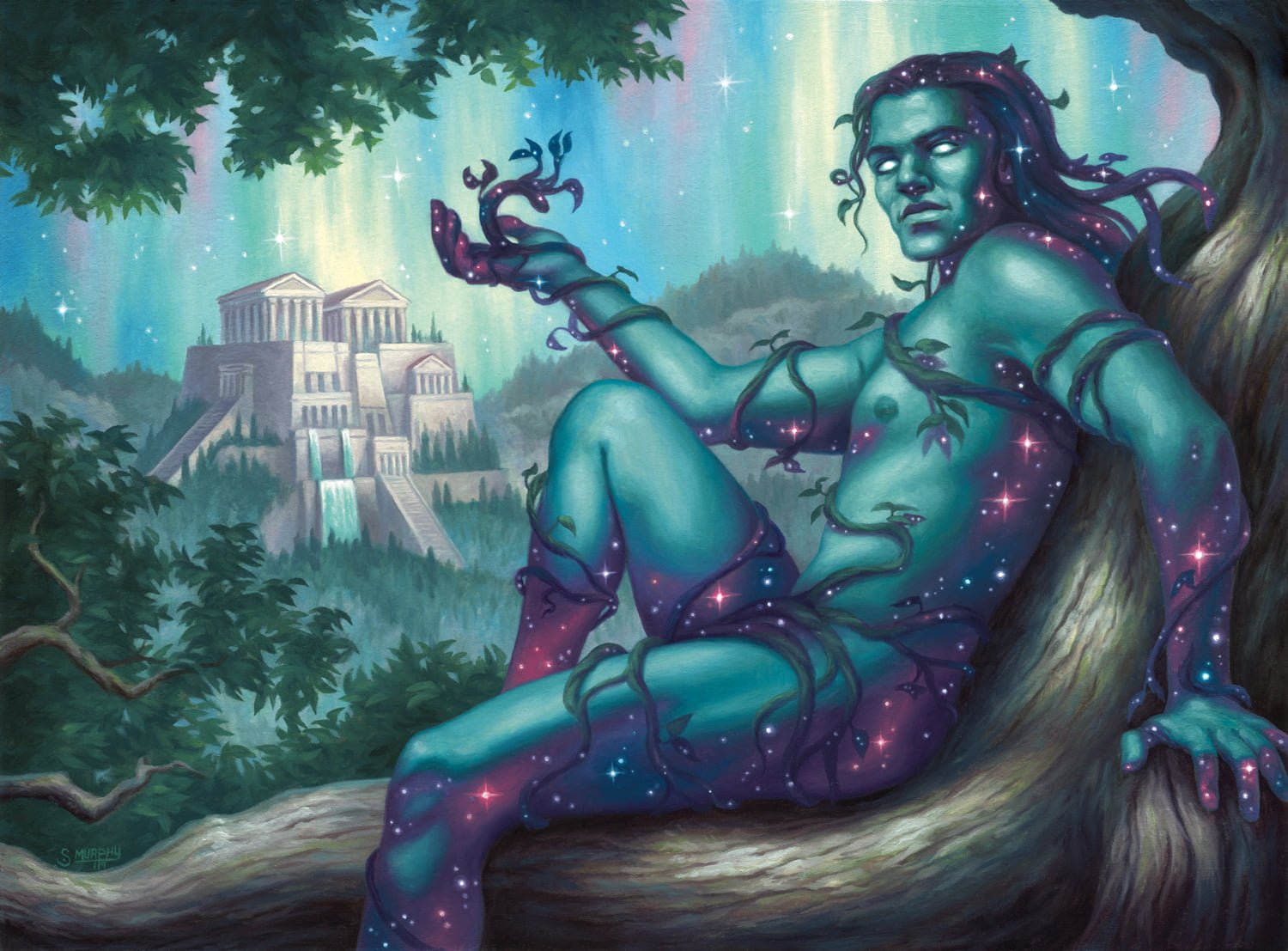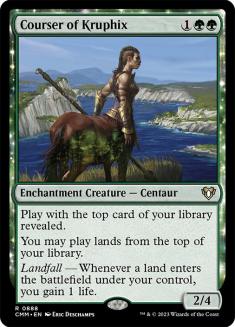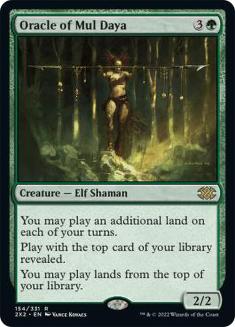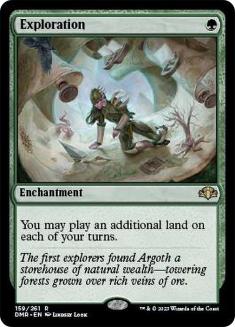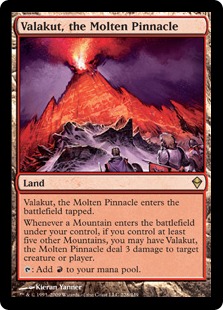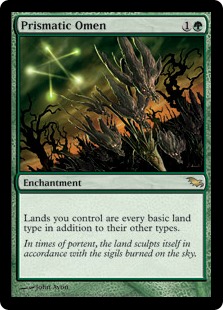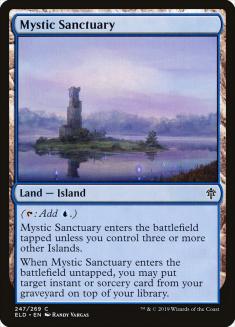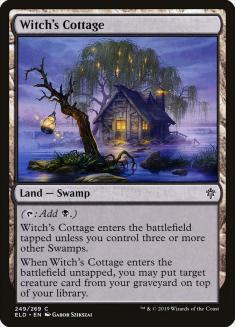The joy of preview season is seeing radically different perspectives on cards and knowing that one of them (sometimes, all of them!) is sure to be wrong. New cards are hard to evaluate at the best of times, prompting all sorts of harebrained analogies as we try to make sense of the unknown. Recently I declared my love for a new hit from Theros Beyond Death, Dryad of the Ilysian Grove.
As I was mentally walking Ilysia’s most impressive Dryad to the altar, Brad Nelson decided that he does actually have a reason why these two should not be wed and that he should speak now instead of forever holding his peace. Not only did he crash our wedding, he compared my beloved to American Pie 2: an uninspired sequel in a franchise buoyed mostly by nostalgia. I couldn’t live with myself if I let that go unchallenged.
Today, Brad will learn why this card is really a Shrek 2: a delightful follow-up to a true classic featuring more character development, bigger and better special effects, and cartoon donkeys lip-syncing to Livin’ La Vida Loca.
Even if you have no interest in a new card, these discussions illuminate how the game’s top minds think about card choices.
As the best Standard player in the world for many years, it makes sense that Brad sees Courser of Kruphix or Oracle of Mul Daya as the most natural comparisons informing his analysis of green’s mission creep in the color pie and its effect on Standard. For him, the Prismatic Omen text is a secondary feature that opens up marginal deckbuilding options and buffs Nissa, Who Shakes the World — already the best card in several of its Standard formats — even further.
If you’re playing Dryad of the Ilysian Grove in Standard, you need to make good use of the Exploration text. As Brad notes, these Exploration knockoffs have severe diminishing returns unless you have a way to draw more cards. A deck with enough lands that it always has extras to play will have barely any slots left to divide between the rewards for acquiring all that mana, the interaction needed to stay afloat, and the card draw or manipulation that ties the room together. To make the numbers work, these decks typically need a land itself as a payoff: the titular Valakut, the Molten Pinnacle and Field of the Dead or the motley crew of Draft rejects that somehow makes Amulet Titan work. It’s rare to find those lands in Standard and after Field of the Dead’s reign of terror last year, I expect land designs to be even more cautious.
The strength of these effects is also highly contextual. Summer Bloom was unplayable for a long time but became a ban-worthy menace in the right shell. Azusa, Lost but Seeking shared Standard with Summer Bloom, Sakura-Tribe Scout, and the Ravnica bouncelands but the payoffs weren’t there to make this a viable strategy. Oracle of Mul Daya earned its day in the sun a decade ago with an in-built way to mitigate its most common fail case while Jace, the Mind Sculptor and the Zendikar fetchlands let you stack the deck or spin the wheel again.
For this new Standard, Dryad of the Ilysian Grove pales in comparison to a flagship mythic from the same set:
Among the many lines of text on Uro, we find safeguards against these common drawbacks. The escape ability ensures you have a reward worth chasing once you have enough mana and the lifegain helps justify spending a turn exploring without affecting the battlefield. Getting a card back up front makes the effect much less risky — Arboreal Grazer and Explore are less similar than they appear. A Simic Ramp shell sporting Uro with Tamiyo, Collector of Tales and Cavalier of Thorns builds itself and I expect this to be a staple in Standard with Theros Beyond Death:
Creatures (21)
- 4 Hydroid Krasis
- 4 Arboreal Grazer
- 1 Agent of Treachery
- 4 Cavalier of Thorns
- 4 Gilded Goose
- 4 Uro, Titan of Nature's Wrath
Planeswalkers (6)
Lands (29)
Spells (4)

As someone who primarily plays Modern and enjoys pushing the boundaries of big mana decks, Dryad’s main appeal to me is access to Prismatic Omen in shells that couldn’t support it before with several extra benefits. Its synergy with Valakut, the Molten Pinnacle is the obvious draw here: with Dryad and one Valakut the sixth land (no longer the seventh land and the sixth Mountain) and every subsequent land gives you a Lightning Bolt. Every Wooded Foothills becomes a double Bolt (with one at instant speed!) and any additional copies of Valakut get out of control quickly. An effect like Scapeshift that finds multiple Valakuts is game over.
Brad explains neatly why Grazer and friends are poorly suited to traditional builds of Valakut but it’s worth asking why the deck needs the help. As seemingly every other deck was juiced up or created from nothing with War of the Spark through Throne of Eldraine, classic TitanShift remained largely the same. This raising of the bar exposed structural flaws inherent to ramp decks but also some specific to TitanShift. Scapeshift generating a tower of Valakut or Field of the Dead triggers was often called a one-card combo as it didn’t require a specific second piece — it isn’t an Angel’s Grace pining for its Ad Nauseam.
In practice, Scapeshift is more like an eight-card combo where you have much more redundancy on the other seven cards. TitanShift has more redundancy on each key element — land drops, acceleration, and payoffs — than typical “combo” decks, so it cares less about card quality but has to care more about card quantity. As a result, it mulligans poorly and cannot readily exploit the London Mulligan, a critical flaw in modern Magic.
Recent releases give Primeval Titan fans new ways of tackling these issues. Magic Online legend stainerson (aka Tommy Ashton) put TitanShift back on the map with a list inspired by Jacob Nagro:
Creatures (12)
Lands (29)
Spells (19)

Castle Garenbrig is a clear standout, enabling not just more consistent Titans but faster Titans. For a ramp deck, five mana is a lot less than six which is a lot less than seven. In conjunction with Arboreal Grazer and Search for Tomorrow this new land ensures that Turn 3 Titan, formerly a rare treat for Through the Breach variants, is a realistic goal for mainstream TitanShift.
The split between Valakut and Field of the Dead is notable here: Field is much quicker at taking over the battlefield while Valakut can go over the top of any battlefield or pick off problem permanents. This isn’t so much a TitanShift deck as a Gruul Titan deck that can pivot easily to whichever plan the situation calls for.
With the format narrowing around Urza and the blue decks trying to fight it, the hive mind quickly arrived at Simic Titan focusing on using Cavern of Souls to force through Titan and take over the battlefield with multiple copies of Field of the Dead:
Creatures (12)
Planeswalkers (4)
Lands (30)
- 2 Forest
- 1 Swamp
- 1 Island
- 1 Snow-Covered Island
- 2 Snow-Covered Forest
- 1 Overgrown Tomb
- 1 Breeding Pool
- 1 Ghost Quarter
- 1 Simic Growth Chamber
- 1 Vesuva
- 1 Tolaria West
- 3 Misty Rainforest
- 1 Bojuka Bog
- 2 Cavern of Souls
- 1 Radiant Fountain
- 1 Field of Ruin
- 1 Blast Zone
- 1 Prismatic Vista
- 3 Field of the Dead
- 4 Castle Garenbrig
Spells (14)

This mono-green base is remarkably adaptable: it’s easy to imagine a Golgari Titan deck using Thoughtseize and Fatal Push as cheap, all-purpose answers to survive the early turns. The Castle Garenbrig / Arboreal Grazer / Once Upon a Time package is a useful template for Modern ramp decks including ones we’ll see later that look very different. In a world of Spell Queller, Force of Negation, and Stubborn Denial, Primeval Titan is often the most reliable payoff. Once Upon a Time offers access to Titan without Pact’s susceptibility to all of those cards as well as ensuring consistent acceleration via Castle, Grazer, and tertiary ramp like Sakura-Tribe Elder. Most decks use Once Upon a Time to find specific creatures or specific lands; the Titan decks maximize the card’s potential by digging for both.
With Dryad of the Ilysian Grove, we can push that envelope even further. Prismatic Omen was often awkward in older TitanShift lists, as it demanded both other ramp cards and a way to find Valakut, making it a virtual mulligan too often in an archetype that could barely afford that. It was hard to lean into Omen, as the second copy did nothing and even the blue-based ramp decks didn’t have ways to find it consistently.
Despite all this, the upside was high enough that many lists took the risk. Dryad not only makes the same offer, it boosts you towards that crucial threshold of six lands. By maxing on Dryad and Valakut, we unlock a two-card interactive combo that doesn’t require resolving an expensive spell; Once Upon a Time finds both halves of this combo, meaning we can win many games just by making land drops.
This has important deckbuilding implications. We no longer need to load up on Scapeshifts and redundant Titans that clog up our hand when resources are low, as we have extra threats priced into card choices we were making anyway. This allows us to play extra lands for our Grazers and Dryads and makes it easier to sideboard out contextually weak or redundant ramp spells. Having more threats relieves the pressure on Summoner’s Pact to always find Titan and Dryad makes Pact useful before you have mana for Titan, giving it a refreshing versatility (notably you can Pact for and cast Dryad on Turn 3, make a land drop to set up the Pact payment, and get up to six lands for Valakut on the following turn). Between Once Upon a Time and our more flexible Pacts, we have reliable access to sideboard bullets like Collector Ouphe or Obstinate Baloth without spending many slots.
Creatures (16)
Lands (29)
Spells (15)

Hour of Promise has seen some play with Prismatic Omen as fetching a pair of Valakuts generates a Scapeshift-esque finish for much fewer mana. As above, Grazer and Search make five mana a crucial breakpoint and a Turn 3 Hour puts the game out of reach on Turn 4.
If this were the limit of Dryad’s potential, I’d still be excited to play with the card. History shows the Omen effect is capable of much more:
Creatures (3)
Planeswalkers (1)
Lands (27)
Spells (29)

Creatures (4)
Lands (28)
Spells (32)

Gerry Thompson joked that Mihara deserved a Hall of Fame slot for that deck alone and it’s hard to disagree. Ford’s list, the brainchild of big mana aficionado Matthias Hunt, shows how effective Omen was in Extended’s much smaller card pool even without playing 68 cards or Exotic Orchard. What if the best shell for Omen then, or Dryad now, contained no actual Mountains at all?
Creatures (18)
- 1 Skyshroud Ranger
- 4 Sakura-Tribe Scout
- 4 Primeval Titan
- 1 Elvish Rejuvenator
- 4 Arboreal Grazer
- 4 Dryad of the Ilysian Grove
Lands (31)
Spells (11)

This list uses the concepts above to execute a faster and more flexible version of Simic Titan’s gameplan. Dryad opens up not just Valakut but Mystic Sanctuary and Witch’s Cottage as fetchable rebuys for key threats. The implicit mana-fixing offered by Dryad alongside eight fetchlands allows this mono-green shell to splash sideboard cards easily. This deck makes good use of bouncelands and Castle Garenbrig but can still support Damping Sphere, a powerful hate piece against faster big mana as well as Gifts Storm and previous Mox Opal combo decks.
A year ago, I made my individual SCG Tour debut by winning the Worcester Open with an Amulet Titan list featuring Through the Breach and Wayward Swordtooth. Both of these cards are a lot better with Field of the Dead so I’m keen to revisit that shell, but Dryad fills a similar role to Swordtooth in providing the extra land plays the deck craves while promising a better backup plan if you make the required sacrifices.
Amulet Titan has a lot of moving parts but most of them, including the namesake Amulet of Vigor, aren’t necessary for the deck to do its thing; the other namesake, Primeval Titan, is crucial and the most common fail case of the deck is not having a Titan on time. It’s hard to splice a secondary win condition into the deck and there are no good extra ways to find Titan, which is why Once Upon a Time was such a valuable addition.
Creatures (16)
Lands (30)
- 2 Forest
- 1 Snow-Covered Forest
- 1 Gemstone Mine
- 3 Gruul Turf
- 1 Breeding Pool
- 1 Ghost Quarter
- 4 Simic Growth Chamber
- 1 Vesuva
- 2 Tolaria West
- 1 Misty Rainforest
- 4 Valakut, the Molten Pinnacle
- 1 Verdant Catacombs
- 1 Bojuka Bog
- 1 Cavern of Souls
- 1 Radiant Fountain
- 1 Crumbling Vestige
- 1 Hanweir Battlements
- 1 Field of the Dead
- 2 Castle Garenbrig
Spells (14)

How good Amulet Titan is in a matchup largely depends on how well a Primeval Titan can stabilize the battlefield without Amulet. Field of the Dead turning Primeval Titan into Grave Titan was a big improvement but the deck is still weak to flyers or other evasion and creatures that bypass the battlefield. With Dryad allowing Primeval Titan to rain down Valakut triggers, nothing that can take damage is safe. This dream team can shoot down Ashiok, Dream Render, a popular and effective hate card for this strategy. There is some tension early between bouncelands and the actual land count for Valakut and Field of the Dead but, once your engine is online, bouncelands provide an endless source of triggers to lock the game up.
Blue-based Omen lists never got off the ground in Modern but Dryad may breathe new life into them.
Creatures (13)
Planeswalkers (2)
Lands (29)
- 1 Forest
- 1 Plains
- 1 Island
- 4 Windswept Heath
- 1 Snow-Covered Plains
- 1 Snow-Covered Forest
- 1 Overgrown Tomb
- 1 Temple Garden
- 1 Stomping Ground
- 1 Breeding Pool
- 1 Simic Growth Chamber
- 1 Kabira Crossroads
- 4 Misty Rainforest
- 4 Valakut, the Molten Pinnacle
- 1 Celestial Colonnade
- 1 Halimar Depths
- 1 Khalni Garden
- 1 Prairie Stream
- 1 Field of the Dead
- 1 Mystic Sanctuary
Spells (16)

Bring to Light Scapeshift has often been on the cusp of playability but the need for Mountains for the manual Scapeshift kill and the desire to build reactive decks full of Remands and Cryptic Commands place tight constraints on what this shell can do. Field of the Dead makes Scapeshift a terrifying win condition at the cost of easier deckbuilding requirements. Bring to Light is sure to find a winner — Scapeshift or Hour of Promise to end the game, Wrath of God or Unmoored Ego to stop creature or combo decks in their tracks, or sideboard tools like Crumble to Dust. Path to Exile shines here as a cheap and versatile interactive spell in an otherwise clunky deck and doubles as a ramp spell with Arboreal Grazer or Wall of Blossoms.
Brad may have the last laugh when it comes to Dryad of the Ilysian Grove, but I hope these ideas give you food for thought as we end a preview season for a set trying its hardest to meet Throne of Eldraine‘s sky-high bar.

